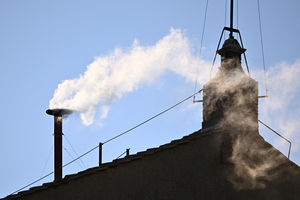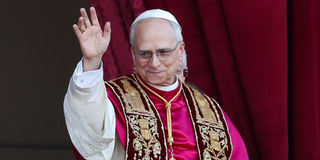
Newly elected Pope Leo XIV, Cardinal Robert Prevost of the United States, appears on the balcony of St. Peter's Basilica at the Vatican, May 8, 2025.
The 267th Pope of the Roman Catholic Church is American-born Robert Francis Prevost, who chose the name Leo XIV after his election on Thursday.
His profile on the Vatican website says he was born on September 14, 1955 (he turns 70 this year) in Chicago, the US state of Illinois.
He was ordained as a priest on June 19, 1982. Whereas his predecessor Pope Francis belonged to the Jesuit order, Pope Leo XIV is from the Augustinian order.
“On November 3, 2014, Pope Francis appointed him apostolic administrator of the diocese of Chiclayo, Peru, elevating him to the dignity of bishop and assigning him the titular diocese of Sufar,” his profile reads. “On January 30, 2023, Pope Francis appointed Cardinal Prevost as prefect of the Dicastery for Bishops and president of the Pontifical Commission for Latin America.”
It adds that he was created and proclaimed cardinal by Pope Francis “in the Consistory of 30 September 2023, of the Deaconry of Santa Monica”.
“He is the second Roman Pontiff from the Americas after Pope Francis. However, unlike Jorge Mario Bergoglio…,he is from the northern part of the American continent,” Vatican News reported yesterday evening.
Reuters reported that the Pope Leo XIV was a relative unknown on the global stage: “Originally from Chicago, he has attracted interest from his peers because of his quiet style and support for Pope Francis’ 12-year papacy, especially his commitment to social justice.”
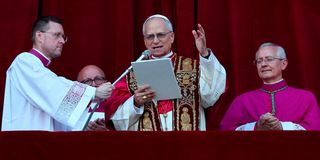
Newly elected Pope Leo XIV, Cardinal Robert Prevost of the Unites States delivers the "Urbi et Orbi" (to the city and to the world) message from the balcony of St. Peter's Basilica, at the Vatican, May 8, 2025.
An analyst on the Catholic-centred EWTN channel described his ascension as “quite a surprise to a few people”.
Pope Leo XIV won two-thirds of the votes cast by the 133 cardinal electors on the second day, same as his two predecessors who also ascended to the papacy after the first day of the conclave (cardinals enclosing themselves and cutting themselves out from the outside world as they vote).
On Thursday, by the time the morning voting was completed, no one had garnered two-thirds of the cardinals’ votes, and so the smoke from the Sistine Chapel was black.
The black smoke billowed at 12.50pm Kenyan time, after which the cardinals took a lunch break. The first black smoke appeared on Wednesday night.
No Pope in modern times has been elected on the first attempt, and so Wednesday’s black smoke was widely expected. Pope Francis, the first pontiff from Latin America, was elected on the evening of the second day of the last conclave, held in 2013, as was his predecessor, Benedict XVI, in 2005.
At 6.08pm Kenyan time, white smoke billowed from the Sistine Chapel in the Vatican as the bell rang. This sent excitement around the world and among the masses gathered at St Peter’s Square, eagerly awaiting a signal.
In Thursday's morning session, the Holy See’s press office reported that “around 15,000 people had gathered in St Peter’s Square to await the announcement”.
“Among those in the square were Sarah and Cameron, a newlywed couple from Indiana in Rome for their honeymoon. They told Kielce Gussie that they had been due to attend Mass with Pope Francis on Thursday, but that although saddened that this is no longer the case, they know that ‘this is a once in a lifetime opportunity’,” said the press office, otherwise known as Vatican News.
Did you know what happens before the white smoke appears? The Vatican’s media arm explained in a post on Wednesday that an elaborate rite precedes it.
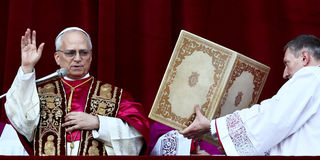
Newly elected Pope Leo XIV, Cardinal Robert Prevost of the Unites States delivers the "Urbi et Orbi" (to the city and to the world) message from the balcony of St. Peter's Basilica, at the Vatican, May 8, 2025.
“According to the rules laid out in the Ordo Rituum Conclavis and the Apostolic Constitution Universi Dominici Gregis, when one of the cardinals present in the Sistine Chapel has received the required majority, and the election has taken place canonically, the senior cardinal by order and age (or, if he is the one elected, the next in line) asks, in Latin and on behalf of the entire college of electors, for the elected cardinal’s consent with the words: ‘Do you accept your canonical election as Supreme Pontiff?’ Upon receiving the consent, he then asks: ‘By what name do you wish to be called?’
“The Master of Pontifical Liturgical Celebrations, acting as notary and with two ceremonial officers as witnesses, then draws up a document confirming the elected Pope’s acceptance and the name he has chosen.
“The Apostolic Constitution Universi Dominici Gregis states that the conclave ends once the new Pope accepts his election ‘unless he decides otherwise’.
“After the rite of acceptance is completed, all the ballots and other election-related documents are burnt, and the resulting white smoke signals to the world that a new Pope has been chosen."
While the faithful in St Peter’s Square applaud and the world awaits the name of the new Pope, the newly elected Pontiff exits the Sistine Chapel and enters the ‘Room of Tears’. There, with the help of the Master of Liturgical Celebrations, he removes the cardinal’s vestment, puts on one of the three prepared papal garments, and spends a few minutes in prayer.
The other frontrunners in the search for the pontiff, according to an analysis by Reuters as the world waited for the white smoke, included Cardinal Jean-Marc Aveline, a 66-year-old from Marseille. He is known for his easy-going nature, readiness to crack jokes and ideological proximity to Francis, especially on immigration and relations with the Muslim world.
The other was Cardinal Charles Maung Bo, a 76-year-old from Myanmar. His appointment in a Buddhist-majority country grabbed headlines in 2015.
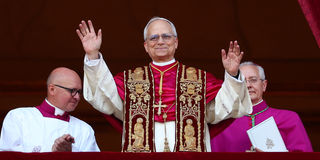
Newly elected Pope Leo XIV, Cardinal Robert Prevost of the United States appears on the balcony of St. Peter's Basilica, at the Vatican, May 8, 2025.
Another name that was being mentioned was that of Cardinal Peter Erdo, 72, from Hungary. His was considered a compromise candidature, as someone from the conservative camp who has built bridges with Francis’ progressive world. Cardinal Erdo was also considered a contender in the 2013 conclave due to extensive contacts in Europe and Africa.
Sixty-eight-year-old Cardinal Mario Grech was also said to hold sway. Hailing from Gozo, a tiny island that is part of Malta, he was initially viewed as a conservative. However, he has become a torchbearer for Pope Francis’ reforms, becoming more open to issues such as LGBT rights and Holy Communion for divorcees.
Morocco’s Cardinal Cristobal Lopez Romero was also considered a key contender. The Spanish-born archbishop of Rabat, Morocco, 72, is known for his missionary work and strong advocacy for migrants. However, he had made it clear that he does not want to be Pope.
Cardinal Pietro Parolin, a 70-year-old Italian, was also being looked at as a compromise candidate between progressives and conservatives. He has been a church diplomat for most of his life and served as Pope Francis’ secretary of state since 2013. The position is similar to that of a prime minister and is often called the “deputy pope” because they rank second to the pontiff in the Vatican hierarchy.
Sixty-seven-year-old Cardinal Luis Antonio Tagle from the Philippines was another prelate on people’s lips. He has often been called the “Asian Francis” because of his easy laugh and commitment to social justice. In a move seen by some as a strategy by Francis to give Cardinal Tagle some Vatican experience, Pope Francis in 2019 appointed him head of the Church’s missionary arm.
The other frontrunner was Cardinal Matteo Maria Zuppi, a 69-year-old Italian known as a “street priest”. He focuses on migrants and the poor, and cares little about pomp and protocol. He goes by the name of “Father Matteo”, and in Bologna – where he is the archbishop – he often uses a bicycle rather than an official car.
The matter of continuing Pope Francis’ vision on various matters, various outlets reported, played a key part in deciding his successor. After all, 108 of the 133 cardinal electors had been appointed by Pope Francis. To become pontiff, one needed 89 votes.


